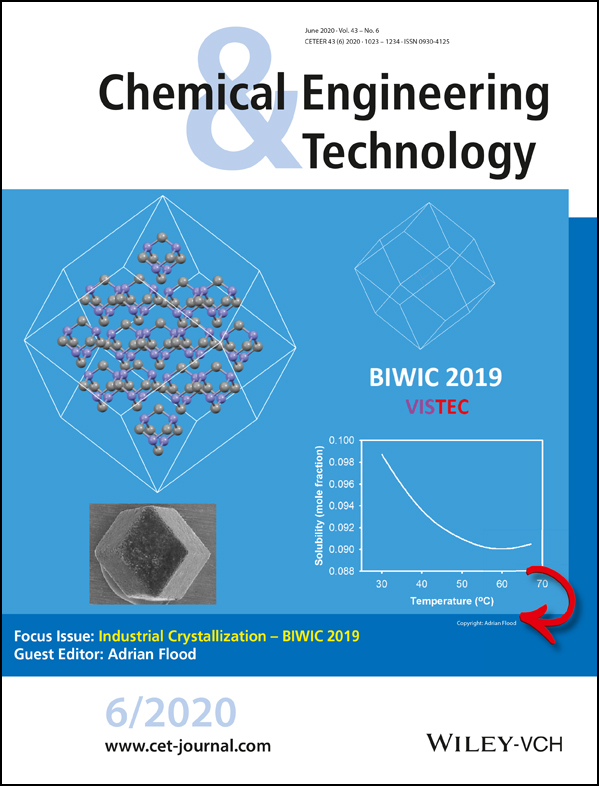Thermodynamic Models and Central Composite Design for Calcium Sulfate Dihydrate Solubility
Corresponding Author
Bercem Kiran-Yildirim
Marmara University, Faculty of Engineering, Chemical Engineering Department, Goztepe, 34722 Istanbul, Turkey
Correspondence: Bercem Kiran-Yildirim ([email protected]), Marmara University, Faculty of Engineering, Chemical Engineering Department, 34722 Goztepe, Istanbul, Turkey.Search for more papers by this authorAybala Gencaslan
Marmara University, Faculty of Engineering, Chemical Engineering Department, Goztepe, 34722 Istanbul, Turkey
Search for more papers by this authorSibel Titiz-Sargut
Marmara University, Faculty of Engineering, Chemical Engineering Department, Goztepe, 34722 Istanbul, Turkey
Search for more papers by this authorCorresponding Author
Bercem Kiran-Yildirim
Marmara University, Faculty of Engineering, Chemical Engineering Department, Goztepe, 34722 Istanbul, Turkey
Correspondence: Bercem Kiran-Yildirim ([email protected]), Marmara University, Faculty of Engineering, Chemical Engineering Department, 34722 Goztepe, Istanbul, Turkey.Search for more papers by this authorAybala Gencaslan
Marmara University, Faculty of Engineering, Chemical Engineering Department, Goztepe, 34722 Istanbul, Turkey
Search for more papers by this authorSibel Titiz-Sargut
Marmara University, Faculty of Engineering, Chemical Engineering Department, Goztepe, 34722 Istanbul, Turkey
Search for more papers by this authorAbstract
The solubility of calcium sulfate dihydrate (gypsum) was measured in HCl solutions in the presence of Cr3+ and Fe3+ ions at various temperatures. The results indicate that the solubility of gypsum is fairly dependent on the concentrations of HCl and impurities, i.e., Cr3+ and Fe3+ ions. The experimental data were analyzed by applying the Buchowski-Kiazczak (λh) model and the modified Apelblat model. Some thermodynamic parameters, such as the standard molar dissolution enthalpy, the standard molar Gibbs energy, and the entropy of solutions, were calculated by Van't Hoff analysis and Gibbs equation. The influences of the concentrations of both HCl and impurities, i.e., Cr3+ and Fe3+ ions, and temperature on the gypsum solubility were examined by applying the central composite design.
References
- 1 H. E. Farrah, G. A. Lawrance, E. J. Wanless, Hydrometallurgy 2007, 86 (1–2), 13–21. DOI: https://doi.org/10.1016/j.hydromet.2006.10.003
- 2 G. Azimi, V. G. Papangelakis, J. E. Dutrizac, Fluid Phase Equilib. 2007, 260 (2), 300–315. DOI: https://doi.org/10.1016/j.fluid.2007.07.069
- 3 G. Azimi, V. G. Papangelakis, Chemical Modeling of Calcium Sulphate Phase Equilibria in Multicomponent Electrolyte Solutions, 2008 AIChE Annual Meeting, Philadelphia, PA, November 2008.
- 4 G. Azimi, V. G. Papangelakis, Hydrometallurgy 2010, 102 (1–4), 1–13. DOI: https://doi.org/10.1016/j.hydromet.2009.12.009
- 5 J. E. Dutrizac, Hydrometallurgy 2002, 65 (2–3), 109–135. DOI: https://doi.org/10.1016/S0304-386X(02)00082-8
- 6 C. C. Templeton, J. C. Rodgers, J. Chem. Eng. Data 1967, 12 (4), 536–547. DOI: https://doi.org/10.1021/je60035a020
- 7 E. Posnjak, Am. J. Sci. 1938, 35A, 247–272.
- 8 E. P. Partridge, A. H. White, J. Am. Chem. Soc. 1929, 51 (2), 360–370. DOI: https://doi.org/10.1021/ja01377a003
- 9 W. L. Marshall, R. Slusher, E. V. Jones, J. Chem. Eng. Data 1964, 9 (2), 187–191. DOI: https://doi.org/10.1021/je60021a011
- 10 A. E. Hill, J. H. Wills, J. Am. Chem. Soc. 1938, 60 (7), 1647–1655. DOI: https://doi.org/10.1021/ja01274a037
- 11 E. Cetin, I. Eroglu, S. Ozkar, J. Cryst. Growth 2001, 231 (4), 559–567. DOI: https://doi.org/10.1016/S0022-0248(01)01525-1
- 12 S. K. Hamdona, U. A. Al Hadad, J. Cryst. Growth 2007, 299 (1), 146–151. DOI: https://doi.org/10.1016/j.jcrysgro.2006.11.139
- 13 A. Al-Othman, G. P. Demopoulos, Hydrometallurgy 2009, 96 (1), 95–102. DOI: https://doi.org/10.1016/j.hydromet.2008.08.010
- 14 W. L. Marshall, E. V. Jones, J. Phys. Chem. 1966, 70 (12), 4028–4040. DOI: https://doi.org/10.1021/j100884a045
- 15 W. L. Marshall, R. Slusher, J. Phys. Chem. 1966, 70 (12), 4015–4027. DOI: https://doi.org/10.1021/j100884a044
- 16 W. L. Marshall, R. Slusher, J. Chem. Eng. Data 1968, 13 (1), 83–93. DOI: https://doi.org/10.1021/je60036a027
- 17 H. Buchowski, A. Ksiazczak, S. Pietrzyk, J. Phys. Chem. 1980, 84 (9), 975–979. DOI: https://doi.org/10.1021/j100446a008
- 18 T. Li, Z. X. Jiang, F. X. Chen, B. Z. Ren, Fluid Phase Equilib. 2012, 333, 13–17. DOI: https://doi.org/10.1016/j.fluid.2012.07.014
- 19 A. Apelblat, E. Manzurola, J. Chem. Thermodyn. 1997, 29 (12), 1527–1533. DOI: https://doi.org/10.1006/jcht.1997.0267
- 20 Z. Li, G. P. Demopoulos, J. Chem. Eng. Data 2005, 50 (6), 1971–1982. DOI: https://doi.org/10.1021/je050217e
- 21 Z. Li, G. P. Demopoulos, Ind. Eng. Chem. Res. 2006, 45 (13), 4517–4524. DOI: https://doi.org/10.1021/ie0600339
- 22 Z. Li, Measurement and Chemical Modeling of Calcium Sulfate Solubilities in Concentrated Chloride Media, Ph.D. Thesis, McGill University, Montreal, QC 2006.
- 23 D. R. Delgado, F. Martinez, Fluid Phase Equilib. 2013, 360, 88–96. DOI: https://doi.org/10.1016/j.fluid.2013.09.018
- 24 R. R. Krug, W. G. Hunter, R. A. Grieger, J. Phys. Chem. 1976, 80 (21), 2341–2351. DOI: https://doi.org/10.1021/j100562a007
- 25 P. Bustamante, S. Romero, A. Pena, B. Escalera, A. Reillo, J. Pharm. Sci. 1998, 87 (12), 1590–1596. DOI: https://doi.org/10.1021/js980149x
- 26 E. K. Panteli, E. K. Voutsas, J. Chem. Eng. Data 2009, 54 (3), 812–818. DOI: https://doi.org/10.1021/je800596c
- 27 A. A. El-Bindary, A. Z. El-Sonbati, E. H. El-Mosalamy, R. M. Ahmed, Chem. Pap. 2003, 57 (4), 255–258.
- 28 S. Baluja, E. A. M. Alnayab, A. Hirapara, Acta Chim. Pharm. Indica 2017, 7 (4), 117.
- 29 J. Fu, Y. Zhao, Q. Wu, J. Hazard. Mater. 2007, 144 (1–2), 499–505. DOI: https://doi.org/10.1016/j.jhazmat.2006.10.071




